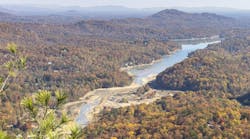
Last week, scientists released the first images from NOAA’s new weather satellite, GOES-16. The images have four times the resolution of existing satellite imagery, and they will allow more accurate weather predictions, including more timely thunderstorm, tornado, and hurricane warnings. The GOES-16 satellite will be able to provide a full image of the planet every 15 minutes, and an image of the continental US every five minutes.
In a press release, Stephen Volz, director of NOAA’s Satellite and Information Service, said, “One of our GOES-16 scientists compared this to seeing a newborn baby’s first pictures—it’s that exciting for us. These images come from the most sophisticated technology ever flown in space to predict severe weather on Earth. The fantastically rich images provide us with our first glimpse of the impact GOES-16 will have on developing life-saving forecasts.”
GOES-16’s Advanced Baseline Imager “has the ability to target regional areas where severe weather, hurricanes, wildfires, volcanic eruptions, or other high-impact environmental phenomena are occurring as often as every 30 seconds,” according to NOAA. The ABI has 16 channels—two in the visible spectrum, four near-infrared, and 10 infrared—and data from these channels will allow forecasters to distinguish atmospheric phenomena like clouds, water vapor, smoke, ice, and volcanic ash.
The satellite was launched in November and is part of a planned series of four satellites that will improve our hurricane warning system.
You can see NOAA’s image gallery here, including comparisons of GOES-16 imagery with that from earlier-generation satellites.
About the Author
Janice Kaspersen
Janice Kaspersen is the former editor of Erosion Control and Stormwater magazines.

